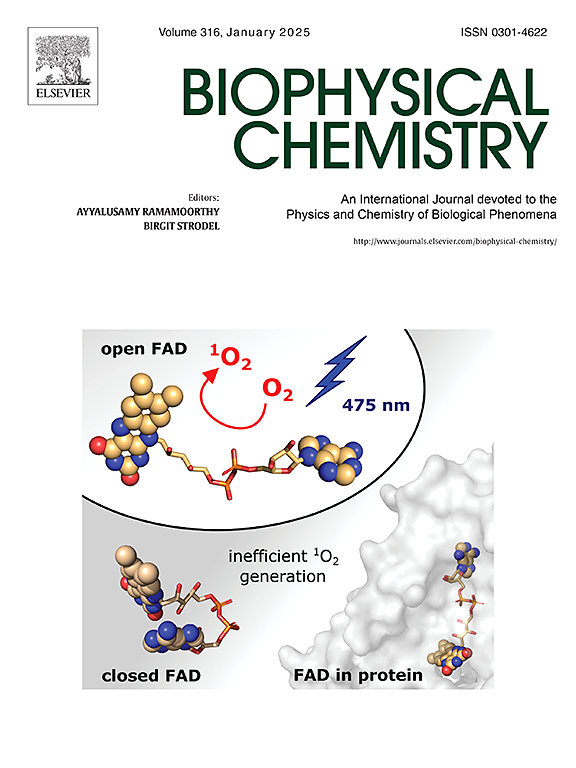Transmembrane clustering of short amyloid peptide fragments: A coarse grained molecular dynamics study
IF 2.2
3区 生物学
Q2 BIOCHEMISTRY & MOLECULAR BIOLOGY
引用次数: 0
Abstract
Toxicity of amyloid peptides has been linked to peptide aggregation and interactions with lipid bilayers. In this work we use coarse-grained molecular dynamics simulations to study aggregation and transmembrane clustering of short amyloid peptide fragments, Aβ(25–35) and Aβ(29–42), in the presence of dipalmitoylphosphatidylcholine (DPPC) and palmitoylolyoilphosphatidylcholine (POPC) bilayers. First, we explored peptide aggregation starting from free monomers placed at the interface of preformed lipid membranes. At low peptide concentrations, no transmembrane clusters were formed in DPPC or POPC membranes. At high peptide concentration, the longer fragment, Aβ(29–42), showed strong peptide-peptide interactions that led to spontaneous formation of transmembrane clusters in POPC and DPPC. However, the shorter fragment, Aβ(25–35), did not form transmembrane clusters within the simulation time in either bilayer. To overcome the free-energy barriers to transmembrane clustering, we changed the simulation protocol and started simulations from random mixtures of peptides, lipids, and solvent. Using this system self-assembly approach, we found that both Aβ(25–35) and Aβ(29–42) can form stable transmembrane clusters in DPPC and POPC bilayers. Our study suggests that the cooperative effects induced by a localized increase in peptide density may be a mechanism of membrane disruption by short amyloid peptide fragments.

短淀粉样肽片段的跨膜聚类:粗粒度分子动力学研究
淀粉样肽的毒性与肽聚集和与脂质双分子层的相互作用有关。在这项工作中,我们使用粗粒度的分子动力学模拟来研究短淀粉样肽片段Aβ(25-35)和Aβ(29-42)在双棕榈酰磷脂酰胆碱(DPPC)和棕榈酰磷脂酰胆碱(POPC)双层存在下的聚集和跨膜聚集。首先,我们探索了从放置在预成型脂质膜界面上的自由单体开始的肽聚集。在低肽浓度下,DPPC或POPC膜中没有形成跨膜簇。在高肽浓度下,较长的片段Aβ(29-42)表现出强烈的肽-肽相互作用,导致POPC和DPPC中自发形成跨膜簇。然而,较短的片段Aβ(25-35)在模拟时间内没有在两层中形成跨膜簇。为了克服跨膜聚类的自由能障碍,我们改变了模拟方案,从多肽、脂质和溶剂的随机混合物开始模拟。利用这种系统自组装方法,我们发现Aβ(25-35)和Aβ(29-42)都可以在DPPC和POPC双层中形成稳定的跨膜团簇。我们的研究表明,由局部肽密度增加引起的协同效应可能是短淀粉样肽片段破坏膜的机制。
本文章由计算机程序翻译,如有差异,请以英文原文为准。
求助全文
约1分钟内获得全文
求助全文
来源期刊

Biophysical chemistry
生物-生化与分子生物学
CiteScore
6.10
自引率
10.50%
发文量
121
审稿时长
20 days
期刊介绍:
Biophysical Chemistry publishes original work and reviews in the areas of chemistry and physics directly impacting biological phenomena. Quantitative analysis of the properties of biological macromolecules, biologically active molecules, macromolecular assemblies and cell components in terms of kinetics, thermodynamics, spatio-temporal organization, NMR and X-ray structural biology, as well as single-molecule detection represent a major focus of the journal. Theoretical and computational treatments of biomacromolecular systems, macromolecular interactions, regulatory control and systems biology are also of interest to the journal.
 求助内容:
求助内容: 应助结果提醒方式:
应助结果提醒方式:


